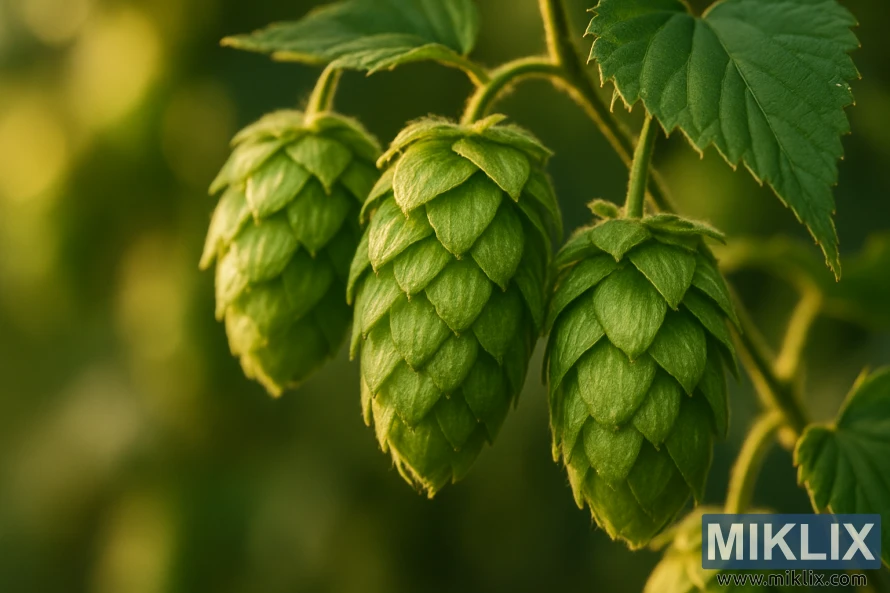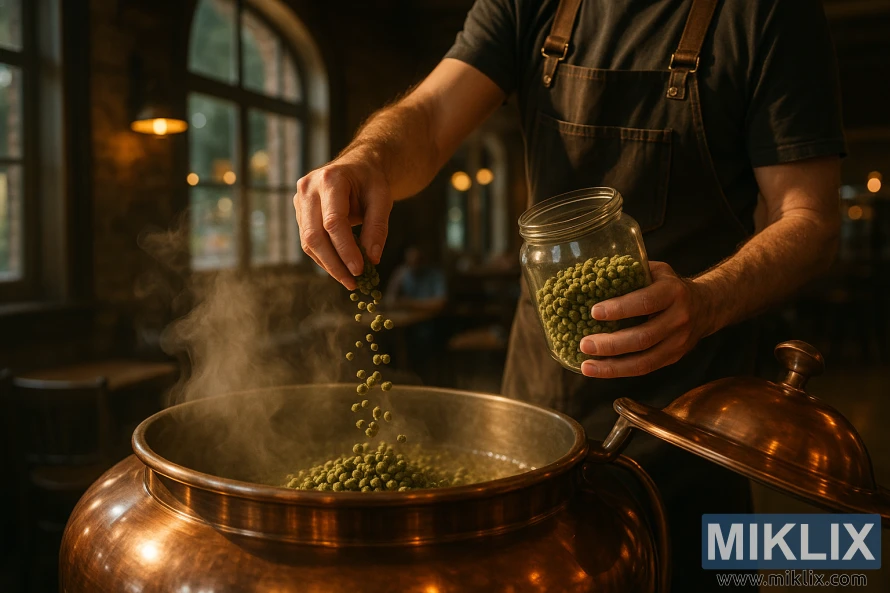Hops in Beer Brewing: Phoenix
Published: October 28, 2025 at 10:58:59 PM UTC
Introduced in 1996, Phoenix hops are a British variety from Horticulture Research International at Wye College. They were bred as a seedling of Yeoman and quickly gained recognition for their balance. This balance makes them a reliable choice for both bittering and aroma in ales.

Alpha levels for Phoenix hops range from 9–12%, with reports suggesting 8–13.5%. This range allows brewers to use it for steady bitterness or to enhance aroma with late additions. The hop's flavor profile includes molasses, chocolate, pine, spice, and floral notes, adding depth without overwhelming malt or yeast.
In Phoenix brewing, the hop's clean finish is beneficial across various styles. It's suitable for traditional British bitters and milds, as well as modern pale ales and porters. Despite lower yields, several British craft breweries and international brewers value Phoenix for its consistent performance.
This article aims to be a practical guide for brewers and suppliers worldwide. It covers the origin, agronomy, chemical composition, flavor profile, brewing techniques, and commercial use of Phoenix hops. This information will help you decide when and how to use Phoenix hops in your recipes.
Key Takeaways
- Phoenix hops are a dual-purpose British hop variety released in 1996 from Wye College.
- Phoenix alpha acids typically fall between 8 and 13.5%, commonly cited at 9–12%.
- The variety offers smooth bitterness and aromatic notes of molasses, chocolate, pine, spice, and floral hints.
- It performs well for both bittering and aroma additions and suits traditional and modern beer styles.
- Agronomically, Phoenix shows good disease resistance but may yield less than some commercial varieties.
Introduction to Phoenix Hops and Their Role in Brewing
Phoenix hops are a reliable choice for British ales, developed at Wye College and introduced in 1996. They were bred to be disease-resistant, an alternative to Challenger. Craft brewers and homebrewers appreciate them for their consistent performance.
Phoenix hops serve as a dual-purpose hop, valued for their ability to enhance both bitterness and aroma. They are suitable for early boil additions and late additions for aroma. Their smooth bitterness is preferred over aggressive herbal notes.
The flavor and aroma of Phoenix hops include chocolate, molasses, pine, spice, and floral notes. These aromas are aromatic but not overpowering. This balance makes Phoenix ideal for balanced recipes across various styles, from bitters to stouts.
Phoenix hops are known for their versatility and clean finish, supporting malty bases. They offer steady alpha acids, reliable hop character, and complement rather than dominate a beer.
For those seeking a multi-role hop, Phoenix is a solid choice. This overview helps brewers understand the value of a hop that offers both aroma nuance and predictable bittering.
Origin and Breeding History of Phoenix Hops
The journey of Phoenix hops began at Wye College. Horticulture Research International's breeders chose a Yeoman seedling with great potential. Their goal was to merge classic British aroma with enhanced disease resistance.
The HRI Phoenix breeding project, known by the code PHX and cultivar ID TC105, aimed high. It sought to surpass Challenger in flavor complexity while boosting field resilience.
By 1996, Phoenix was available for widespread cultivation. Craft brewers took notice, despite its lower yields. Initial reviews highlighted its aromatic richness, hinting at its potential as a favorite among craft brewers.
Exploring Phoenix hop origin, we see its connection to Wye College and the Yeoman seedling. The HRI Phoenix breeding research is key to grasping its creation and objectives.

Botanical and Agricultural Characteristics
Phoenix hails from the United Kingdom, showcasing classic English hop traits. Plants form medium cones with loose to moderate density. These hop cone characteristics make the variety easy to evaluate during sorting and processing.
Seasonal maturity is early; harvest typically begins in September and runs into early October in England. Growers note a low to moderate growth rate in the bine, which affects planning for trellis space and labor.
Phoenix yields are modest, usually reported between 980–1560 kg per hectare (870–1390 lbs per acre). This range places Phoenix below many high-yield varieties, so growers who prioritize output may look elsewhere.
Harvesting Phoenix is often described as difficult. The loose cone structure and bine habit demand careful hand work or tuned mechanical settings to reduce loss and maintain quality.
Phoenix disease resistance is mixed. The variety shows reliable resistance to verticillium wilt and powdery mildew. It remains vulnerable to downy mildew, which calls for targeted scouting and timely fungicide programs in wet seasons.
Commercially, Phoenix is grown in the UK and listed by international suppliers in pellet form. Many craft growers choose this hop when flavor and disease resistance are more important than maximum production.
- Country of origin: United Kingdom.
- Cone size and density: medium, loose to moderate—key hop cone characteristics for processing.
- Season: early maturity; harvest in September–early October.
- Growth and yield: low to moderate growth with Phoenix yields of about 980–1560 kg/ha.
- Harvest ease: challenging, requires attention to handling.
- Disease profile: Phoenix disease resistance to verticillium wilt and powdery mildew; susceptible to downy mildew.
- Availability: grown in the UK and offered internationally in pellet form.
For growers, Phoenix is a strategic choice when hop cone characteristics and disease resilience outweigh the need for maximum tonnage. Planting decisions should weigh labor, local downy mildew pressure, and market demand for the variety's flavor profile.
Chemical Composition and Brewing Values
Phoenix alpha acids typically range from about 8% to 13.5%, with many tests clustering near a 10.8% average. This makes Phoenix useful for both early bittering and later aroma additions. The target IBU and mash profile determine the timing.
Phoenix beta acids sit lower, generally 3.3% to 5.5%, averaging around 4.4%. These acids contribute more to aroma and aging stability than to hop bitterness in the kettle.
The alpha-beta ratio varies by crop year and report, most often falling between 1:1 and 4:1, with a practical mean near 3:1. This balance helps brewers choose dosage for clean bittering or rounded hop character.
Phoenix co-humulone accounts for roughly 24% to 33% of the total alpha acids, averaging about 28.5%. This suggests a bitterness quality that can be smooth but at times shows a slightly firmer, more defined bite.
Total hop oils in Phoenix range from 1.2 to 3.0 mL per 100 g, with an average near 2.1 mL per 100 g. The Phoenix oil composition breaks down into key terpenes that shape aroma and flavor.
- Myrcene: about 23%–32%, typically near 24% on average; brings resinous, citrus, and fruity notes.
- Humulene: roughly 25%–32%, often close to 30%; adds woody, spicy, noble hop character.
- Caryophyllene: near 8%–12%, commonly around 11%; gives peppery, herbal tones.
- Farnesene: about 1%–2%, usually 1%–1.5%; offers fresh, green, floral nuances.
- Other volatiles such as β-pinene, linalool, geraniol, and selinene make up roughly 30%–37% of the oil fraction.
For brewers, this mix means Phoenix works as a dual-purpose hop. The measured Phoenix alpha acids and Phoenix oil composition support reliable bittering. They also leave enough volatile content for pleasing late-hop aroma.
Crop-year variability impacts exact contributions, so checking individual lot analysis is a good practice. Monitoring reported Phoenix co-humulone and oil breakdown helps predict whether the hop will favor clean bitterness or a more assertive aromatic presence.

Aroma and Flavor Profile of Phoenix Hops
Phoenix hops present a complex aroma, leaning towards dark, malty notes rather than bright citrus. They are known for their molasses and chocolate undertones, complemented by a soft pine top note. This unique profile makes them ideal for brown ales and mild bitters, where depth is more important than bold aromatics.
Many describe the flavor of Phoenix hops as a blend of molasses and chocolate pine. While spice and floral hints are present, they are subtle. This subtlety allows Phoenix to add complexity without overpowering the malt or yeast esters.
In brewing, Phoenix hops offer smooth bitterness and a broad aromatic base. They are often added early in the boil for consistent bittering. Late additions can vary, so it's crucial to plan blends with this in mind.
When combined with traditional UK hops like East Kent Goldings or Fuggle, Phoenix enhances the beer's malt backbone. It adds nuanced flavor notes that complement rather than dominate the brew.
- Best use: beers needing subtle spice and chocolate tones.
- Typical contribution: rounded bitterness with layered aromatics.
- Expect variation: aroma intensity can change by harvest year.
Brewing Applications and Best Practices
Phoenix hops serve as a dual-purpose variety, excelling in bittering. Brewers often prefer it for its stable bitterness. To achieve this, add Phoenix hops early in the boil. This maximizes its 8–13.5% alpha acids. Early additions result in a smooth, rounded bitterness, ideal for British ales and robust malty recipes.
For a modest aroma, incorporate Phoenix hops in the late addition or whirlpool. A Phoenix late addition imparts subtle chocolate, pine, and spice notes. Its aroma is milder compared to highly aromatic hops. Adjust the contact time and temperature to enhance its character without extracting vegetal tones.
Dry-hopping with Phoenix can be hit-or-miss. Many brewers find the aroma to be subtle and sometimes inconsistent. Use Phoenix as a supporting dry-hop for a bold, citrus-forward profile, rather than the sole aroma source.
- Typical use: early boil for Phoenix bittering.
- Whirlpool/late: use Phoenix late addition for gentle aromatics.
- Dry-hop: usable, best in blends or when subtlety is desired.
Blending enhances the outcome. Pair Phoenix with East Kent Goldings or Fuggle for traditional English character. For modern ales, combine Phoenix with brighter hops like Citra or Centennial. This adds citrus or resinous lift while Phoenix supports bitterness and depth.
Form and dosing are crucial. Phoenix is available as whole cone and pellet hops from reputable suppliers like Charles Faram and BarthHaas. There are no Cryo or lupulin-concentrate versions available. Calculate hop rates based on alpha and oil values. Always check the crop-year lab data, as alpha acids and oils vary with harvest.
- Check lab analysis for alpha and oil levels.
- Use early additions for Phoenix bittering.
- Reserve late additions or whirlpool hops for subtle spice and pine.
- Blend for stronger aroma or modern character.
Small recipe tip: enhance late-hop presence with slightly higher mass or warmer whirlpool rests. This brings out more chocolate and pine notes without losing the smooth bitterness Phoenix is known for. Monitoring crop-year variation ensures consistent recipes across batches.

Beer Styles That Showcase Phoenix Hops
Phoenix hops add a subtle floral spice, perfect for traditional English styles. They complement malt balance in English Ales, Extra Special Bitter (ESB), Bitter, and Golden Ales. This hop variety enhances the herbal top note, allowing malt and yeast to shine while Phoenix adds a layer of complexity.
In dark, malt-forward beers, Phoenix's deeper tones are a boon. It complements the chocolate and molasses notes in porters and stouts, enhancing roast and caramel malts. Phoenix in stouts fortifies the beer's backbone without overpowering the roast character.
Craft brewers also use Phoenix in modern pale and IPA blends for added depth. It's ideal for hazy or balanced modern beers, where smooth bitterness and floral-spicy aromatics are key. While it may not be the star in hop-forward West Coast IPAs, it enriches the mid-range hop profiles in balanced recipes.
- Traditional English: English Ale, ESB, Bitter — Phoenix in English ales shines as a complementary hop.
- Dark ales: Porter, Stout, Brown Ale — supports roast and caramel notes.
- Modern blends: Pale Ales and balanced IPAs — adds depth without dominating citrus or resin.
For recipes seeking smooth bitterness, floral-spicy aroma, and subtle chocolate or molasses undertones, Phoenix is a top choice. Its versatility makes it a standout across various beer styles, enhancing the overall flavor profile.
Pairing Phoenix Hops with Malts and Yeasts
When pairing Phoenix hops with malts, focus on rich, malty bases. Opt for Maris Otter or British pale malt to create a solid foundation. This enhances the hop's chocolate and molasses notes.
Adding Munich or light crystal/caramel malts brings in sweetness and body. A small amount of crystal malt will highlight fruit and caramel, without overpowering Phoenix's complexity.
In porters and stouts, darker roasts like chocolate malt or roasted barley are ideal. They amplify Phoenix's darker aromatics. Ensure the roast levels are balanced to preserve the hop's spice and cocoa character.
For pale ales, malt-hop pairing with Phoenix requires caution. Lighter malt bills can add complexity, but bright, citrusy hops are needed to maintain a dynamic hop aroma.
- Maris Otter and British pale malt: malty foundation.
- Munich and crystal: add roundness and caramel notes.
- Chocolate malt, roasted barley: strengthen chocolate/molasses tones.
The choice of yeast for Phoenix hops significantly impacts flavor. British ale strains like Wyeast 1968 London ESB or White Labs WLP002 English Ale enhance traditional English character and esters. These complement Phoenix's unique profile.
Neutral American strains, such as Wyeast 1056 or White Labs WLP001, allow bitterness and subtle hop aroma to shine. These yeasts provide a clean canvas for malt-hop pairing with Phoenix.
Higher-ester English strains boost spice and floral notes. Use warmer fermentation and lower attenuation yeasts to emphasize malt richness. This deepens Phoenix's aromatic profile.
- Wyeast 1968 / WLP002: accentuate malt and English hop tones.
- Wyeast 1056 / WLP001: clean expression, clearer hop bitterness.
- Warmer fermentation with lower attenuation: enhances esters and malt presence.
Balance is crucial. Adjust malt complexity, yeast character, and fermentation temperature to shape Phoenix's presentation. Thoughtful pairing and the right yeast will result in beers with layered aroma and satisfying depth.
Substitutions and Comparable Hop Varieties
Brewers seeking Phoenix hop substitutes often turn to traditional UK varieties. Challenger, Northdown, and East Kent Goldings each offer traits that align with Phoenix’s profile.
The debate between Challenger and Phoenix is prevalent among ale brewers. Challenger is known for its solid dual-purpose use, with dependable English character. Phoenix, bred for disease resistance, maintains a similar utility in both bittering and aroma roles.
For a Northdown substitution, expect spicy, woody notes that complement English malt bills. Northdown is ideal when the recipe needs structure, rather than bold citrus or tropical tones.
When aroma is key, consider an East Kent Goldings alternative. East Kent Goldings provides classic floral and noble nuances, helping to recreate Phoenix’s gentler aromatic side in traditional ales.
- Match alpha acids: Phoenix ranges roughly 8–13.5%. Adjust addition rates when substituting to keep bitterness steady.
- Check oil profiles: Myrcene, humulene, and caryophyllene levels change aroma. Scale aroma additions to taste and timing.
- Use step substitutions: Combine a bittering-focused hop like Challenger with an aroma hop such as East Kent Goldings alternative to mimic Phoenix’s balance.
Note a practical limit: there are no cryo-style lupulin concentrates for Phoenix. Cryo, Lupomax, or LupuLN2 equivalents do not exist for this cultivar, so concentrate-based swaps are not directly available.
Trial small batches when swapping hops. Adjust boil times and late additions to reach the desired aroma and bitterness. Record alpha adjustments and sensory notes for repeatable results.
Availability, Forms, and Purchasing Phoenix Hops
Phoenix hops are predominantly sold as pellets and whole-cone varieties. Major processors rarely offer commercial lupulin concentrates for this cultivar.
Several reputable hop merchants supply Phoenix hops. Retailers in the U.S. and abroad, like Amazon (USA), Brook House Hops (UK), and Northwest Hop Farms (Canada), list Phoenix stock. Availability can vary by harvest year and batch size.
When purchasing Phoenix hops, compare crop-year data and lab analyses. Different suppliers may have varied alpha acids, aroma descriptors, and harvest dates. It's crucial to check quantities and pricing before making a purchase.
Phoenix hops have smaller yields and are produced seasonally, which can limit their availability. Brewers with tight schedules should order early or secure contract quantities from specialty distributors.
- Forms: pellet and whole-cone; no widely available lupulin concentrates.
- Identification: international code PHX; cultivar ID TC105.
- Shipping: domestic shipping is common within supplier countries; U.S. brewers can source Phoenix from online hop retailers and specialty distributors.
When buying Phoenix hops, consider shipping time, storage upon arrival, and the harvest year. This ensures the preservation of aroma and bitterness in your brew.

Storage, Stability, and Impact on Brewing Performance
Phoenix hop storage impacts both bittering and aroma. Trials reveal Phoenix retains about 80–85% of its alpha acid after six months at 20°C (68°F). This shows moderate stability but highlights the benefits of cooler storage.
To maintain hop alpha acids and volatile oils, use vacuum-sealed packaging and refrigerate or freeze hops. Minimize air and heat exposure. These steps enhance Phoenix hop stability and safeguard delicate aromas for late additions or dry hopping.
Alpha acid loss diminishes bittering potential. If hops are stored too long, brewers will see a decrease in IBU contribution from the same weight. Volatile oil decline also reduces aroma impact when using older stock for flameouts, whirlpool, or dry hop stages.
Practical steps ensure consistent performance. Verify the supplier's harvest year and lab-tested alpha values before use. Increase addition rates when using older hops to achieve target bitterness.
- Store vacuum-sealed and cold to boost Phoenix hop stability.
- Prioritize fresh hops for late additions and dry hopping to capture aroma.
- Adjust bittering additions based on hop alpha acid retention Phoenix reports.
Adhere to standard hop storage best practices for consistent results. Even with decent storability, attention to packaging, temperature, and inventory rotation ensures Phoenix performs as expected in the brew house.
Case Studies and Examples of Phoenix in Commercial Brews
Several British breweries have incorporated Phoenix into their year-round and seasonal offerings. Fuller’s and Adnams stand out as established UK houses. They prefer hops with a classic English character for crafting balanced bitters and ESBs.
Phoenix is commonly used in traditional English ales, porters, stouts, and bitters. Brewers often use it for early or main bittering additions. This approach ensures a smooth, rounded hop bitterness that complements malt complexity.
Craft brewers report that Phoenix craft beers offer integrated bitterness with subtle aromatics. Tasting notes frequently mention faint chocolate, molasses, and a restrained pine-spice edge. These flavors enhance brown ales and darker malty recipes.
Many breweries combine Phoenix with other English varieties in multi-hop blends. The hop serves as a backbone, adding depth without overpowering late-hop aroma when used conservatively.
Commercial brewers typically source Phoenix hops from UK pellet suppliers or domestic distributors. Due to lower yields and variable harvests, planning is crucial for consistent supply in Phoenix commercial beers.
Small independent breweries provide practical examples. A porter featuring Phoenix as a primary bittering hop showcases a smooth finish and enhanced roast notes. An ESB with Phoenix in the kettle and subtle late additions displays balanced bitterness and gentle spice.
Brewers often reserve Phoenix for malt-forward recipes rather than hop-forward IPAs. This preference underscores why Phoenix craft beers remain popular. They are favored by producers who prioritize malt character and restrained hop interplay.
- Usage: early/main bittering to smooth harshness.
- Styles: bitters, ESBs, porters, stouts, traditional ales.
- Sourcing tip: plan ahead due to limited availability.
Conclusion
Phoenix hops conclusion: Phoenix, a British dual-purpose hop, was introduced in 1996. It stands out as a dependable bittering hop with a subtle aromatic profile. Its smooth bitterness and complex aroma, featuring molasses, chocolate, pine, spice, and floral notes, pair well with malty beers and traditional English styles. Its disease resistance also makes it attractive for growers and brewers looking for consistency.
Why use Phoenix hops: Phoenix is ideal for those crafting porters, stouts, and balanced modern beers. It doesn't overpower the malt. Use it early in the boil for clean bitterness or blend it with more aromatic varieties to enhance depth. Fresh, crop-year pellets are recommended for optimal performance, as there is no Cryo or lupulin-powder form available.
Phoenix hop summary: While Phoenix offers versatility, it has its limitations. It has lower yields, some susceptibility to downy mildew, variable late-addition aroma, and occasional harvesting challenges. If Phoenix is not available, alternatives like Challenger, Northdown, or East Kent Goldings can serve as practical substitutes. Despite these, Phoenix remains a valuable asset for brewers seeking subtle complexity and stable bittering character.
Further Reading
If you enjoyed this post, you may also like these suggestions:
- Hops in Beer Brewing: Brewer's Gold
- Hops in Beer Brewing: Tillicum
- Hops in Beer Brewing: Yakima Cluster
